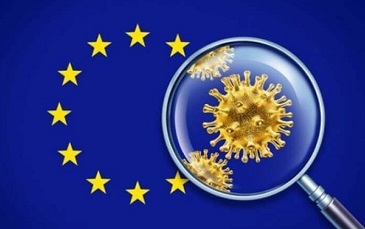COVID-19 News: WHO Warns That Respiratory Infectious Diseases Rising Across Europe. Worrying COVID-19 Trends In Czechia, Finland, Italy, Latvia And Slovakia!
Nikhil Prasad Fact checked by:Thailand Medical News Team Dec 16, 2023 1 year, 3 months, 2 weeks, 11 hours, 7 minutes ago
COVID-19 News: In a recent news release, the World Health Organization (WHO) issued a stark warning about the rising prevalence of respiratory infectious diseases across the WHO European Region.

The onset of the seasonal cold weather has led to the circulation of respiratory pathogens, causing a surge in illnesses, with particular concerns emerging in Czechia, Finland, Italy, Latvia, and Slovakia.
https://onemocneni-aktualne.mzcr.cz/covid-19
https://sampo.thl.fi/pivot/prod/fi/epirapo/covid19case/fact_epirapo_covid19case?row=dateweek20200101-509038L&column=measure-444833.445356.492118.816930.816957.&fo=1
https://github.com/pcm-dpc/COVID-19/blob/master/dati-andamento-nazionale/dpc-covid19-ita-andamento-nazionale.csv
https://data.gov.lv/dati/dataset/covid-19#
https://covid-19.sledilnik.org/en/tables
This
COVID-19 News report delves into the multifaceted challenges posed by these trends, exploring various factors contributing to the current scenario.
A Closer Look at the European Landscape
The European Respiratory Virus Surveillance Summary reveals that approximately half of the countries in the Region are grappling with elevated levels of fever and cough. Disturbingly, some nations are witnessing a significant surge, especially among young children. This echoes a similar trend observed last year, primarily driven by an early seasonal increase in respiratory syncytial virus (RSV), a leading cause of acute lower respiratory tract infections in infants and young children.
RSV, a recurring seasonal virus in Europe, exhibits peaks during the autumn, winter, and spring months, spanning from October to April.
The common symptoms include a runny nose, decreased appetite, coughing, sneezing, fever, and wheezing. While most RSV infections resolve on their own within 1–2 weeks, severe cases can lead to bronchiolitis or pneumonia. WHO closely monitors select respiratory viruses, attributing the recent increase to a peak in RSV infections amid a backdrop of rising COVID-19 cases and a smaller but notable surge in seasonal influenza.
Moreover, several countries in the Region are witnessing an increase in infections and hospitalizations related to Mycoplasma pneumoniae, a common bacterial cause of community-acquired pneumonia among children. This microbial factor adds a layer of complexity to the respiratory health landscape in the region.
gt;Unpacking the Surge in RSV Activity
The surge in RSV activity is reflected in a sharp rise in RSV-related hospitalizations among young children in the past five weeks. Children under 6 months of age account for 20% of acute lower respiratory tract infection episodes and almost half of all RSV deaths in children under 5 years of age. While RSV infection is nearly unavoidable for most children, extra precautions are recommended for preterm babies and infants under 6 months, particularly those with underlying lung and heart disease.
The current increase in RSV-related hospitalizations underscores the vulnerability of young children to respiratory infections. WHO emphasizes the need for heightened vigilance and targeted interventions to protect this demographic group, particularly considering the added risk for toddlers who have not encountered RSV during the COVID-19 pandemic.
The Ongoing Threat of COVID-19
As the winter respiratory illness season unfolds, COVID-19 continues to pose a significant threat, causing severe illness and fatalities, particularly among those over 65 years and individuals with risk factors for severe disease. Although hospitalization rates remain lower compared to the same period last year, half of the countries reporting COVID-19 hospitalization data are witnessing upward trends, notably in Czechia, Finland, Italy, Latvia, and Slovakia.
Dr Marc-Alain Widdowson, High-threat Pathogen Lead at the WHO Regional Office for Europe, sheds light on the situation, stating, "A seasonal increase in respiratory pathogens is expected, but this year's surge could also be attributed to infections among children who were protected during the pandemic, and because some of these pathogens vary in circulation each winter."
Navigating the Vaccination Landscape
Despite the concerning trends, Dr Widdowson emphasized that COVID-19 and influenza vaccine recommendations remain targeted at the same high-risk groups, including older adults, individuals with chronic diseases, those with immunocompromising conditions, pregnant women, and healthcare workers. Encouragingly, both vaccines are recommended for those eligible.
Influenza vaccines, administered safely for decades, and COVID-19 vaccines, credited with saving an estimated 1.5 million lives, are pivotal tools in mitigating the impact of respiratory illnesses. Health authorities continue to engage with vulnerable groups to encourage the uptake of these vaccines and promote protective measures where needed.
Public Health Measures and Future Projections
While acknowledging the increase, health officials underscored the effectiveness of simple measures such as handwashing, staying home when ill, ensuring better ventilation in crowded spaces, and getting vaccinated when offered in curbing the spread of these viruses and protecting vulnerable populations.
As the winter respiratory illness season progresses, with influenza transmission on the rise, WHO remains vigilant, monitoring the situation closely through integrated surveillance for various diseases, supported by reports from national authorities and other sources. Dr. Widdowson urged individuals, communities, and health authorities to take proactive steps in safeguarding public health, dispelling misinformation, and ensuring health systems are equipped to manage multiple threats this winter.
The evolving landscape of respiratory infections in Europe underscores the need for ongoing research, robust surveillance, and dynamic public health responses. WHO continues to work closely with Member States to navigate the complexities of this multifaceted challenge, emphasizing the importance of collective efforts in protecting public health and well-being.
Thailand Medical News would also like to add that besides Czechia, Finland, Italy, Latvia and Slovakia, Poland is also witnessing high levels of rising COVID-19 infections.
https://www.gov.pl/web/koronawirus/wykaz-zarazen-koronawirusem-sars-cov-2
It should be noted that many countries in Europe are also not reporting COVID-19 statistics to the WHO and or even ECDC and some countries like France are applying geolocation blockings to their official health sites as they do not want foreign media reporting on the developing crisis in their countries while local media have already been either restricted or bribed to not to cover on COVID-19 situation!
https://www.santepubliquefrance.fr/dossiers/coronavirus-covid-19/coronavirus-chiffres-cles-et-evolution-de-la-covid-19-en-france-et-dans-le-monde
For the latest COVID-19 News, keep on logging to Thailand Medical News.
